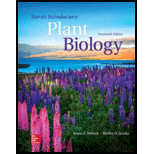
Concept explainers
To Review:
The worth of checking out the past use of plants through the scientific perspective.
Introduction:
The flowers are the reproductive structures of the plants. There are many different types of flowers exist in the plant kingdom.
Explanation of Solution
Based on the structure of flower the plants can be divided into Ranunculaceae, Lauraceae, Papaveraceae, Brassicaceae, Rosaceae, Fabaceae, Euphorbiaceae, Cactaceae, Lamiaceae, Solanaceae, Apiaceae, Cucurbitaceae, Poaceae, Liliaceae, and Orchidaceae.
The flowering family of the poinsettia is Euphorbiaceae.
The flowering family of the lupine is Fabaceae.
The flowering family of the columbine is Ranunculaceae.
The flowering family of the peach is Rosaceae.
The flowering family of the pear is Cactaceae.
The flowering family of the cinnamon is Lauraceae.
The flowering family of the sarsaparilla is Liliaceae.
The flowering family of the belladonna is Solanaceae.
The flowering family of the peyote is Cactaceae.
The flowering family of the horehound is Lamiaceae.
The flowering family of the rubber is Euphorbiaceae.
The flowering family of the jimson weed is Solanaceae.
The flowering family of the parsley is Apiaceae.
The flowering family of the sorghum is Poaceae.
The flowering family of the asparagus is Liliaceae.
The flowering family of the broccoli is Brassicaceae.
The flowering family of the lettuce is Asteraceae.
The flowering family of the tomato is Solanaceae.
The flowering family of the opium is Papaveraceae.
Depending on the structure of the flowers, the classification of the flowers is given above.
Want to see more full solutions like this?
Chapter 24 Solutions
Stern's Introductory Plant Biology
 Human Anatomy & Physiology (11th Edition)BiologyISBN:9780134580999Author:Elaine N. Marieb, Katja N. HoehnPublisher:PEARSON
Human Anatomy & Physiology (11th Edition)BiologyISBN:9780134580999Author:Elaine N. Marieb, Katja N. HoehnPublisher:PEARSON Biology 2eBiologyISBN:9781947172517Author:Matthew Douglas, Jung Choi, Mary Ann ClarkPublisher:OpenStax
Biology 2eBiologyISBN:9781947172517Author:Matthew Douglas, Jung Choi, Mary Ann ClarkPublisher:OpenStax Anatomy & PhysiologyBiologyISBN:9781259398629Author:McKinley, Michael P., O'loughlin, Valerie Dean, Bidle, Theresa StouterPublisher:Mcgraw Hill Education,
Anatomy & PhysiologyBiologyISBN:9781259398629Author:McKinley, Michael P., O'loughlin, Valerie Dean, Bidle, Theresa StouterPublisher:Mcgraw Hill Education, Molecular Biology of the Cell (Sixth Edition)BiologyISBN:9780815344322Author:Bruce Alberts, Alexander D. Johnson, Julian Lewis, David Morgan, Martin Raff, Keith Roberts, Peter WalterPublisher:W. W. Norton & Company
Molecular Biology of the Cell (Sixth Edition)BiologyISBN:9780815344322Author:Bruce Alberts, Alexander D. Johnson, Julian Lewis, David Morgan, Martin Raff, Keith Roberts, Peter WalterPublisher:W. W. Norton & Company Laboratory Manual For Human Anatomy & PhysiologyBiologyISBN:9781260159363Author:Martin, Terry R., Prentice-craver, CynthiaPublisher:McGraw-Hill Publishing Co.
Laboratory Manual For Human Anatomy & PhysiologyBiologyISBN:9781260159363Author:Martin, Terry R., Prentice-craver, CynthiaPublisher:McGraw-Hill Publishing Co. Inquiry Into Life (16th Edition)BiologyISBN:9781260231700Author:Sylvia S. Mader, Michael WindelspechtPublisher:McGraw Hill Education
Inquiry Into Life (16th Edition)BiologyISBN:9781260231700Author:Sylvia S. Mader, Michael WindelspechtPublisher:McGraw Hill Education





